Vitamin C (ascorbic acid) – essential substance for the normal functioning of the human body. Today, ascorbic acid remains the best remedy to strengthen the immune system, especially during the seasons colds. In addition, this vitamin plays important role in the process of producing collagen, necessary to maintain good condition, restore blood vessels, muscles, skeletal system, tissues and cells of the whole body. However, the human body itself does not produce this element. Vitamin C comes only from the food you eat.
Everyone knows tablets, dragees ascorbic acid. Many have taken them or are taking them regularly to maintain health. Ampoules with vitamin C are also used for therapeutic and prophylactic purposes. They are, in particular, prescribed when the body urgently requires additional administration of this substance. It should be noted that ampoules are also actively used in cosmetology.
When is vitamin C prescribed in ampoules - instructions for use, indications for the drug, what are they? To obtain complete information, we used the instructions for the drug included in the package. Based on it, it was compiled this description. However, before using the drug, be sure to read the instructions yourself.
Dosage form
Can everyone use vitamin C in ampoules (indications for use)?
According to the instructions for use, vitamin C injections are prescribed for conditions of increased need for it:
Hypo-or vitamin deficiency;
- Unbalanced or parenteral nutrition;
- During intense physical and mental work;
- Women during lactation, as well as children during periods of intensive growth (according to indications);
-Patients after illnesses, postoperative period;
- In case of tuberculosis, scurvy, burn disease, alcoholism, as well as smoking;
- With prolonged hypothermia, the presence of fever, hyperthyroidism, as well as chronic infections;
- For certain gastrointestinal diseases: persistent diarrhea, peptic ulcer, and also after resection of the small intestine and gastrectomy;
- In case of chronic intoxication with Fe drugs, idiopathic methemoglobinemia.
The drug is also prescribed for long-term stressful conditions, injuries, as well as during pregnancy, especially multiple pregnancies, occurring against the background of alcohol or drug addiction.
How to dose vitamin C in ampoules (application)?
This drug is prescribed by a doctor after an examination. He also determines the course of treatment, as well as the method of administration (intravenous or intramuscular). Typically the duration is 10 days. But, if necessary, the course can be extended, however, not earlier than in a month.
A single administration of the solution should not exceed 200 mg. The daily dosage should not exceed 500 mg.
Application in cosmetology
Ascorbic acid solution in ampoules is also used to improve skin condition. When the solution is applied externally in the form of masks, the complexion improves and fine wrinkles are reduced.
Regular application (2-3 times a week) significantly improves skin condition.
In addition, a solution of vitamin C is used to improve the condition of hair. Simply add the contents of the ampoule to your shampoo, then wash your hair as usual. With regular use, hair becomes strong, shiny, and its elasticity increases.
What are the side effects of the drug “Vitamin C (ampoules)”?
Caution should be exercised when administered intravenously. Too fast a process can cause dizziness and a feeling of fatigue. If you are intolerant to the main component, allergic reactions may occur, accompanied by skin rash, skin hyperemia.
With long-term treatment with large doses of the drug “Vitamin C (in ampoules)”, the instructions for use also warn that signs of thrombocytosis and neutrophilic leukocytosis may be observed. Hyperprothrombinemia, erythropenia, or hypokalemia may occur.
What are the contraindications for use of the “Vitamin C (ampoules)” product?
The drug is not prescribed for individual intolerance. Intravenous administration contraindicated in diabetes mellitus, thrombosis and thrombophlebitis, as well as other conditions accompanied by increased blood clotting or a tendency to them.
Important!
When prescribing increased doses of the vitamin, kidney function must be monitored and regular measurements taken. blood pressure. It is also necessary to monitor your glucose levels.
Patients with hypoacid (anacidic) conditions are prescribed hydrochloric acid with pepsin before the course of injections. This is necessary to eliminate the risk of vitamin C destruction.
It must be remembered that when treated with this drug, some laboratory tests may be distorted, namely: blood levels of glucose, bilirubin, as well as transaminases and lactate dehydrogenase (LDH).
Without a doubt, vitamin C is extremely important element to maintain health, strengthen immune system. However, you need to understand that long-term use or high doses of this substance lead to hypervitaminosis, which is no less harmful to the body than hypovitaminosis. Therefore, use this drug only on the recommendation of your doctor. Be healthy!
Ascorbic acid or vitamin C is known even to a child. Almost everyone knows that this vital element is necessary for the body to maintain immunity and prevent colds and viral diseases. Excellent prophylactic is tea with lemon, citrus fruits and berries, which contain the vitamin. But ascorbic acid can enter the body not only from food, but in the form of special preparations. Today, pharmaceutical companies offer vitamin C in ampoules. Thanks to this form of release, after the injection the drug quickly enters the bloodstream and has a great effect. In addition, it is widely used in cosmetology.
Benefits of ascorbic acid
A very important vitamin for the human body is organic substance, which takes part in most vital processes:
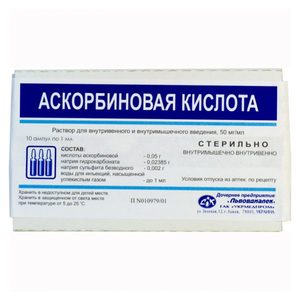
Getting into the human blood with food or as drugs, ascorbic acid is immediately included in all metabolic processes. If there is not enough of it in the body, then many vital processes begin to suffer.
However, the vitamin should not be abused or taken uncontrollably. The drug can disrupt the integrity of the stomach and put a lot of stress on the kidneys. This is why experts recommend saturate the body with vitamin C through injections. Ascorbic acid injections correct doses will help the body and will not harm the gastrointestinal tract.
pharmachologic effect
When administering ascorbic acid intramuscularly or intravenously , it is easily, quickly and simply absorbed. In the body, platelets and leukocytes are involved in its transportation. Compared to blood plasma, they contain 30 times more vitamin concentration.
The drug is metabolized by the liver. It is concentrated in the muscles and lungs, pituitary gland and brain, kidneys and genitals, liver and pancreas. The vitamin is excreted from the body in feces and urine.
Indications for use
Vitamin C injections available in ampoules is used for the following conditions and pathologies:
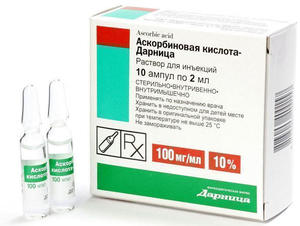
Contraindications
Despite great benefit ascorbic acid for the body, for some diseases it use is contraindicated:
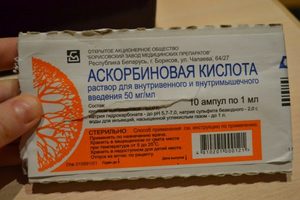
Instructions for the use of ascorbic acid in ampoules
To avoid negative consequences, vitamin C injections should be done strictly in the dosage indicated in the instructions.
Ascorbic acid is administered intravenously either as a stream (over 2–3 minutes) or as a drip (25–30 drops per minute). For drip administration, 50 to 100 ml of 0.9% saline solution or 5% glucose solution is used as a base.
When administered intramuscularly the solution is preheated to room temperature, after which they draw it into a syringe and insert the needle deep into the thickness of the muscle. For injection, use a 5% solution of the drug.
For the treatment of diseases, adults are prescribed from 1 to 5 ml of vitamin one - three times a day. For children, the daily dose of 5% of the drug is 0.6–1.0 ml. The course of treatment depends on the patient’s condition and the severity of the disease.
Injections of ascorbic acid in ampoules should be prescribed after an examination by the attending physician.
special instructions
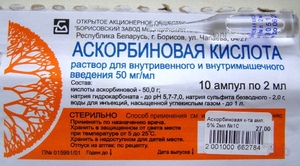 Since one of the key actions of ascorbic acid is the synthesis of corticosteroid hormones, in case of overdose it is possible risk of education kidney stones
. Therefore, treatment with this vitamin should be under the control of the kidneys, adrenal glands and blood pressure.
Since one of the key actions of ascorbic acid is the synthesis of corticosteroid hormones, in case of overdose it is possible risk of education kidney stones
. Therefore, treatment with this vitamin should be under the control of the kidneys, adrenal glands and blood pressure.
The drug should be used with caution if there is a high iron content in the blood.
Exceeding the vitamin norm can lead to a decrease in the functioning of the insular apparatus of the pancreas.
Side effects
In most cases, ascorbic acid is well tolerated by patients, however, while taking the drug Some side effects are possible:
- If the injection is administered quickly, dizziness and fatigue may occur.
- When administered intramuscularly - painful sensations at the injection site.
- In case of overdose - headaches and increased excitability.
- Increased blood pressure due to deterioration of capillary permeability.
- With long-term use and exceeding the dose - impaired renal function, development of nephrolithiasis or moderate pollakiuria.
- In patients prone to allergies, allergic reactions and even anaphylactic shock are possible.
- Development of hypoprothrombinemia, glycosuria, leukocytosis, thrombocytosis, erythropenia.
Storage conditions and prices
Ascorbic acid in ampoules should be stored at air temperatures from +5 ° C to +15 ° C, protected from direct sun rays place. The drug must be inaccessible to children. The shelf life of vitamin injections ranges from one and a half to two years.
Ascorbic acid is inexpensive. The price for a package of 10 ampoules of 2 ml of 5% solution is only about 30 rubles.
Ascorbic acid for face
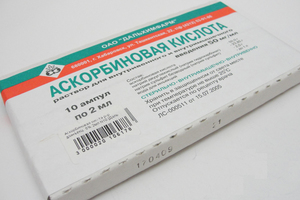 It has been proven that Vitamin C has a positive effect on the skin, therefore, the solution produced in ampoules has long been used in cosmetology.
It has been proven that Vitamin C has a positive effect on the skin, therefore, the solution produced in ampoules has long been used in cosmetology.
Proper use of ascorbic acid nourishes the skin and eliminates redness and flaking, renews cells, and improves complexion.
To maintain facial skin in normal condition, nourish and refresh it, The following procedure is recommended:
- Dilute two ampoules of the drug with boiled water at room temperature in a 1:1 ratio.
- Use the resulting solution to wipe your face, neck and décolleté in the morning and evening after water procedures.
- If after using the solution a burning sensation appears, then you need to add another portion of water.
An excellent effect can be achieved if you use a mask consisting of vitamins C, E, A. The solutions are mixed and applied to the skin. The effect of the mask will be enhanced by combining ascorbic acid and fresh fruit.
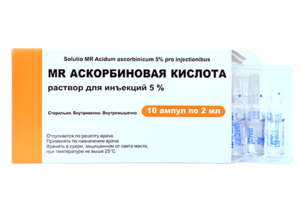
For removing cosmetic defects and improvements appearance professional skins cosmetologists perform facial mesotherapy. During this procedure, a special preparation containing vitamins is injected under the skin using a very thin needle. Injections of ascorbic acid nourish and protect cells from free radicals, improve blood circulation, and have a whitening effect. Such therapy should be trusted only to trusted and certified specialists.
Name: Ascorbic acid injection solution 10%
Active substance
Ascorbic acid*
ATX
A11GA01 Ascorbic acid (vitamin C)
Pharmacological group
Composition and release form
1 dragee contains ascorbic acid 50 mg; V glass jar or bottles of 50, 100 or 200 pcs., or in a blister pack of 10 pcs., in a cardboard pack of 5 packs. 1 ml of solution for injection - 50 or 100 mg; in ampoules of 1 and 2 ml, in cardboard box 10 pcs. 1 tablet - 50 mg; in a glass jar 50 pcs. 1 tablet for children - 25 mg; in a blister pack 10 pcs., in a cardboard box 5 packs each, or in a glass jar 50 or 100 pcs. Powder - 2.5 mg; in paper bags.pharmachologic effect
Pharmacological effect - replenishing vitamin C deficiency.
It forms an ascorbic - dehydroascorbic acid system, which is involved in the transfer of hydrogen and regulates the reduction processes of a number of metabolites and the activity of the monooxygenase system.
Indications for the drug Ascorbic acid injection solution 10%
Hypovitaminosis C, hemorrhagic diathesis, bleeding (nasal, pulmonary, hepatic, uterine), infections, intoxications, liver diseases, adrenal insufficiency, sluggishly healing wounds, ulcers, bone fractures, dystrophy, increased physical and mental stress, pregnancy and lactation.Contraindications
Thrombophlebitis, tendency to thrombosis, diabetes mellitus.Side effects
Hyperglycemia, glucosuria, arterial hypertension.Directions for use and doses
Orally, for prevention, adults - 50-100 mg/day, children - 25 mg/day; for treatment of children - 50-100 mg/day after meals; during pregnancy and lactation - 300 mg for 10-15 days, then - 100 mg/day. IM, IV - 1 ml of 10% or 1-3 ml of 5% solution. Highest dosage: single - not higher than 200 mg, daily - 500 mg.Storage conditions for the drug Ascorbic acid injection solution 10%
In a place protected from light.
Keep out of the reach of children.
Shelf life of the drug Ascorbic acid injection solution 10%
Do not use after the expiration date stated on the package.
International and chemical names: ascorbic acid; (R)-5-[(S)-1,2 dihydroxy-ethyl]-3,4-dihydroxy-5H-furan-2-one;basic physical and chemical properties: colorless or with a slightly yellowish tint, transparent liquid.Active substance: 1 ml of solution contains ascorbic acid - 50 mg or 100 mg;Excipients: sodium bicarbonate, sodium hydrosulfite (E 222), water for injection.
Pharmacological properties:
Pharmacodynamics. Ascorbic Acid is a water-soluble vitamin that promotes optimal transition tissue metabolism. It takes an active part in redox reactions, forming a hydrogen proton transfer system with dehydroascorbic acid, exhibiting biooxidant properties, thereby ensuring the stability of cell membranes. Takes part in the synthesis of the main substance connective tissue vascular wall, which hinders the development. With insufficient intake of Ascorbic Acid from food, bleeding from the gums and mucous membranes develops. Takes part in glucose metabolism, cholesterol catabolism, and synthesis of steroid hormones. During stress reactions, its content in the body, and in the adrenal tissue in particular, is significantly reduced, which confirms the participation of Ascorbic Acid in adaptation reactions. Capable of exhibiting an antianemic effect due to its effect on iron metabolism. Restores ferric iron to divalent iron, the latter is transported through the bloodstream.
Pharmacokinetics. Absorbed without energy expenditure in the small intestine in the form of dehydroascorbic acid. Maximum concentration in the blood after 4 hours. Mainly accumulates in organs with increased level metabolic processes, in particular in adrenal tissue. It is found in tissues both in a free state and in the form of compounds. It is excreted from the body in the urine, both unchanged and in the form of metabolites. The content of Ascorbic Acid in tissues decreases with alcohol consumption and smoking.
Indications for use:
Ascorbic Acid is used for treatment in all clinical situations associated with the need for additional administration of vitamin C. It is prescribed for the treatment of bleeding (uterine, pulmonary, nasal, liver, etc.), hemorrhagic diathesis, bleeding as a syndrome, various intoxications and infectious diseases, pregnant women, Addison's disease, overdose of anticoagulants, bone fractures and flaccid granulating wounds, various dystrophies, during pregnancy and lactation, increased mental stress and increased physical work.
Directions for use and dosage:
Ascorbic Acid is prescribed intramuscularly and intravenously by stream or drip.
It is injected intravenously over 1 to 3 minutes. For intravenous drip administration, a single dose is dissolved in 50 - 100 ml of 0.9% sodium chloride solution and administered by slow intravenous infusion at a rate of 30 - 40 drops per minute. Intramuscularly injected deep into the muscle.
Doses are set individually, taking into account the nature and severity of the disease.
Adults and children over 12 years of age are usually prescribed 50 - 150 mg per day.
Children under 12 years of age are prescribed intravenously at a daily dose of 5 - 7 mg/kg body weight in the form of a 5% solution (0.5 - 2 ml). The maximum daily dose is 100 mg.
In case of poisoning, the daily dose is increased to 500 mg. The maximum single dose is 200 mg, daily dose is 1 g.
Features of application:
When used in large doses, it is necessary to monitor renal function, blood pressure (stimulation of corticosteroid formation by Ascorbic Acid), as well as pancreatic function (suppression of the insular apparatus). Use in pregnant women and during lactation - as prescribed by a doctor. Therapy in large doses should not be carried out in patients with a tendency to recurrent kidney stones. To reduce the risk of crystalluria, patients with renal failure must ensure sufficient fluid intake (1.5 - 2 liters per day). The use of large doses of Ascorbic Acid may affect the results of some laboratory tests: erroneous positive test for the presence of sugar in urine and negative test for the presence of occult blood in the feces, as well as underestimation of results when studying the concentration of lactate dehydrogenase and aminotransferase in the blood serum.
In patients with high iron levels in the body, Ascorbic Acid should be used in minimal doses.
Patients on a low sodium diet should not be prescribed high doses of the drug.
Prescribing Ascorbic Acid to patients with rapidly proliferating and intensively metastasizing tumors can enhance the process. For patients undergoing chemotherapy, Ascorbic Acid should be prescribed no earlier than 1 to 3 days (depending on the half-life of the anticancer drug) after chemotherapy, since there is no clinical evidence of a possible interaction.
Use during pregnancy or breastfeeding. Minimum daily requirement for Ascorbic Acid in II - III trimesters pregnancy - about 60 mg. Ascorbic acid penetrates the placental barrier. It should be borne in mind that the fetus can adapt to high doses of Ascorbic Acid taken by a pregnant woman, and then the newborn may develop ascorbic acid disease as a “withdrawal” reaction. As a result, the drug should not be prescribed during pregnancy. increased doses, unless the potential benefit to the mother exceeds possible risk for the fetus.
The minimum daily requirement for Ascorbic Acid during lactation is 80 mg. A mother's diet containing adequate amounts of Ascorbic Acid is sufficient to prevent deficiency in the infant. Ascorbic acid is released from breast milk. Theoretically, there is a danger to the baby if the mother takes high doses of Ascorbic Acid (it is recommended that a nursing mother not exceed the daily requirement for Ascorbic Acid). If it is necessary to prescribe increased doses of the drug during lactation, breastfeeding should be stopped.
Children. Children under 12 years of age are prescribed intravenously at a daily dose of 5 - 7 mg/kg body weight in the form of a 5% solution (0.5 - 2 ml). The maximum daily dose is 100 mg.
Side effects:
Ascorbic Acid, as a rule, is well tolerated, but with long-term use in large doses, a negative effect on the pancreas, formation of urinary tract calcium oxalate, increased blood pressure, increased excitability of the central nervous system, sleep disturbance, feeling of fatigue, decreased capillary permeability, stomach cramps, development of microangiopathy, allergic reactions, skin hyperemia, hypervitaminosis C, impaired zinc and copper metabolism.
Interaction with other drugs:
Ascorbic Acid increases the blood concentration of salicylates (increases the risk of crystalluria), ethinyl estradiol, benzyl penicillin and tetracyclines, and reduces the blood level of oral contraceptives. Increases the excretion of drugs that have alkaline reaction(including alkaloids). In high doses, it increases the renal excretion of mexiletine.
Tetracyclines and acetylsalicylic acid increase the excretion of ascorbic acid in the urine.
When administered concomitantly with salicylates and short-acting sulfonamides, the risk of urinary stone formation increases.
High doses of Ascorbic Acid can reduce urine pH, resulting in reduced tubular reabsorption of amphetamine and tricyclic antidepressants used simultaneously.
Increases iron excretion in patients taking deferoxamine.
Reduces the anticoagulant effect of coumarin and heparin derivatives and the effectiveness of antibiotics. Increases the destruction and overall clearance of ethyl alcohol.
Reduces the chronotropic effect of isoprenaline and therapeutic effect phenothiazine derivatives.
When used simultaneously with barbiturates and primidone, the excretion of Ascorbic Acid in the urine increases.
Contraindications:
Increased sensitivity to Ascorbic Acid, thrombosis, thrombophlebitis. For diabetes mellitus and recurrent kidney stones, high doses of the drug are not prescribed.
Overdose:
Acute poisoning with Ascorbic Acid has not been described. In case of side effect you must stop using the drug and consult a doctor.
Storage conditions:
Store out of the reach of children, protected from light, at a temperature from +15 °C to +30 °C.
Shelf life - 3 years.
Vacation conditions:
On prescription
Package:
2 ml per ampoule; 10 ampoules in a cardboard pack.
Vitamin C or ascorbic acid is organic compound. Like glucose, it is one of the main substances responsible for normal functioning of the human body, is a restorer of metabolic processes, performs the functions of an antioxidant, and affects blood quality. It is naturally found in many fruits and vegetables.
It's interesting that the names "ascorbic acid" and "vitamin C" are synonymous. Meanwhile, in the composition of the acid, of the many substances that make it up, only vitamin C is active, for which the useful compound received common name, although there are other elements to it as well.
Main properties of vitamin C
Ascorbic acid increases the immune status of the body, strengthens the walls of blood vessels, and prevents the occurrence of increased fatigue, stimulates the production of collagen, which promotes rejuvenation of the body.
Ascorbic acid is contained in almost all vitamin-mineral complexes, which are taken in preventive and medicinal purposes. Without it, many trace elements and minerals cannot be absorbed - for example, iron, phosphorus, selenium.
Intravenous administration of ascorbic acid helps to recover from intoxication and remove “bad” cholesterol. It is extremely difficult to endure a pregnancy with a lack of this vitamin - it is necessary for the development of the fetus. The developing body draws its supply of vitamin C from the maternal reserve, so it is very important to constantly replenish it. Without ascorbic acid, the baby will subsequently lag behind in height and weight.
But is it possible to drink ascorbic acid during pregnancy in the form of vitamins, or do you need to increase the amount of vegetables and fruits in your diet? There is an opinion among ordinary people that ascorbic acid during pregnancy leads to the threat of miscarriage. If you want to interrupt unwanted pregnancy It is enough to drink 1-3 packs of vitamins, and you will not have to go to any doctor to eliminate the unwanted condition.
Is it true?
The most important trimester

The beginning of pregnancy is considered one of the most important and crucial periods in terms of gestation. It is in the first trimester that the formation of the main organic systems of the fetus occurs.
At this time, you really should not overuse vitamin C. It increases the immune status of the body, which, when a new life is born, must necessarily be less than normal, otherwise the embryo will be rejected, as foreign body. Therefore, doctors at this time advise not only to refuse additional doses vitamin complex, but also limit the consumption of citrus fruits, strawberries, cherries and currants of all types - these products contain an increased amount of this substance.
However, during pregnancy with normal course– despite the “horror stories” from word of mouth – it is unlikely that it will be possible to terminate a pregnancy without resorting to official medicine.
Most likely, you will develop an allergy and cause renal and hepatic colic.
After formation corpus luteum During pregnancy, ascorbic acid can be prescribed intravenously if there is a threat of miscarriage due to increased vascular permeability. A symptom of the condition is bleeding. In other cases, to replenish the reserve of this substance, you can increase the content of the above products in the diet.
II and III trimesters

A dropper with ascorbic acid and glucose during pregnancy is prescribed for severe toxicosis. The minimum daily requirement of the fetus for this vitamin is 60-80 mg g per day. If a woman constant vomiting, then the condition leads not only to dehydration - the fetus begins to lag in development.
To restore the water-electrolyte balance, Ringer's solution or saline is administered, and the nutritional deficiency is covered by glucose. Together with ascorbic acid, it is administered intravenously during pregnancy because in this way they are better accepted by the body.
Intravenous infusion is performed in the 2nd and 3rd trimesters for relief uterine bleeding. It is especially important to install an IV when late toxicosis in a state of gestosis. In the third trimester, just before childbirth, intravenous infusion will not only help cope with organic problems, but also have a positive effect on the birth process. The elasticity of tissues increases, the walls of blood vessels are strengthened. This helps reduce bleeding and avoid multiple ruptures.
Features of vitamin C administration
The following factors are contraindications to the use of vitamin C:
- individual intolerance;
- thrombophlebitis;
- thrombosis;
- diabetes;
- urolithiasis disease.

Has a negative impact a large number of vitamin C on the pancreas, stimulating its hyperfunction, and the kidneys - they are not able to remove all processed products from the body after absorption, and therefore a state of preeclampsia may occur - edema will appear.
There is a risk of obstructive jaundice. It is used with caution in patients with erosive diseases of the digestive organs and only in the form of a dropper with ascorbic acid. During pregnancy, vitamin C penetrates to the fetus, overcoming the placental barrier.
Therefore, when prescribing high doses of the drug, the addictive effect should be taken into account. The fetus adapts to high doses of this substance and after withdrawal it begins to develop ascorbic acid disease, the symptoms of which resemble “withdrawal” in drug addicts. In a newborn, basic reflexes are inhibited, tremors of the limbs appear, and vomiting may begin.
Therefore, if it is necessary to prescribe increased doses of a beneficial compound, it is necessary to compare possible risks for the body of the mother and the unborn baby.
Side effects of overdose for a pregnant woman:

- temperature increase;
- a condition resembling menopausal hot flashes;
- sleep disorder;
- headache;
- increased blood clotting and blood clot formation.
Despite the possibility of obtaining the necessary supply of ascorbic acid in the body from food, many women try to introduce it artificially.
Such "therapeutic measures" are not always justified.
Reinsurance can have negative impact on the baby’s health after birth and can cause further allergic reactions to eating foods with a high content of vitamin C.
You cannot haphazardly purchase and drink a complex of vitamins during pregnancy on your own! If required, necessary appointments the doctor will do it.
